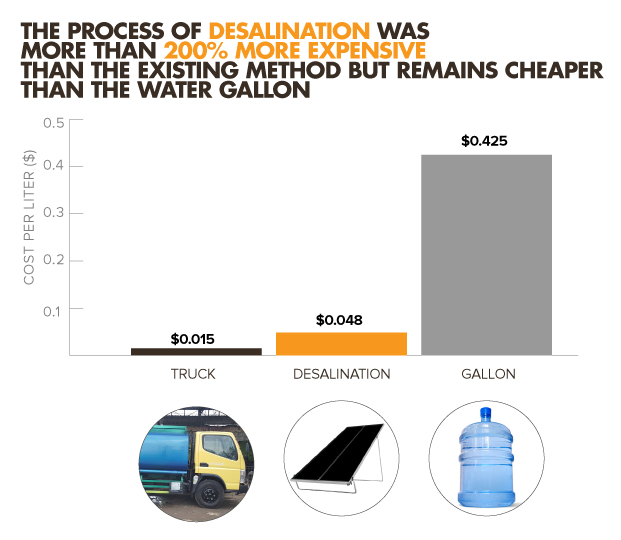
Kopernik’s Solutions Lab recently experimented with a solar desalination technology designed to provide drinking water for households living in coastal areas with limited access to drinking water. FCubed’s Carocell 3000 model was tested with a household located in a remote coastal area of East Flores. From a technical perspective, the technology demonstrated it could produce an average of ten liters of safe drinking water per day (short of the 20 liters per day that the product description suggested), just enough to fulfill the needs of an average-sized household of 4 people.1 From an economic perspective, however, the technology remains significantly more expensive than the locally available alternative methods of procuring clean drinking water. Even if the product produced 20 liters per day, the technology remains 60% more expensive than the cheapest alternative method.
In the project location, water is currently sourced from a fresh water spring which has been gradually drying out over the past few years, building concern that the area’s source of fresh water will disappear entirely. If this indeed becomes reality, families will be forced to purchase fresh drinking water from a water truck that visits the area once every two weeks or by purchasing gallon water from the closest town where it is available, Maumere. Due to the isolation of the village, transport costs make purchasing water more costly than in better-connected areas.

Over its three year lifespan, the Carocell 3000 water purifier can produce drinking water at around $0.048 per liter,2 which is over 200% more expensive when compared to water from the truck ($0.015/liter). It remains cheaper however than the cost per liter of buying water gallons ($0.425).3 In order for the desalinator to be more affordable than the water delivered by truck, the technology needs to produce at least 33 liters of water per day.
These findings suggest that while this particular desalinator is able to function well in producing drinkable water, it does not offer a positive return on investment for a family with access to drinking water for anywhere under five cents a liter. Considering the high up-front investment of approximately US$525 and the need for regular maintenance, it is unlikely to be the preferred method of accessing drinking water. While more cost-effective, large capacity desalinators exist, we observe a critical gap in the market for an affordable desalination solution with a scale suitable for a single household or a small neighborhood.
Have you had any experience with finding cost-effective desalination technology for small coastal communities? You can read full findings from the project here.
2 This cost includes the cost of the technology and import taxes. It does not include the cost of local shipping or maintenance over the years, thus the per liter cost is likely to be even higher.
3 This is per liter cost of gallon assuming the household already has the gallon container and is only paying for the refill.


